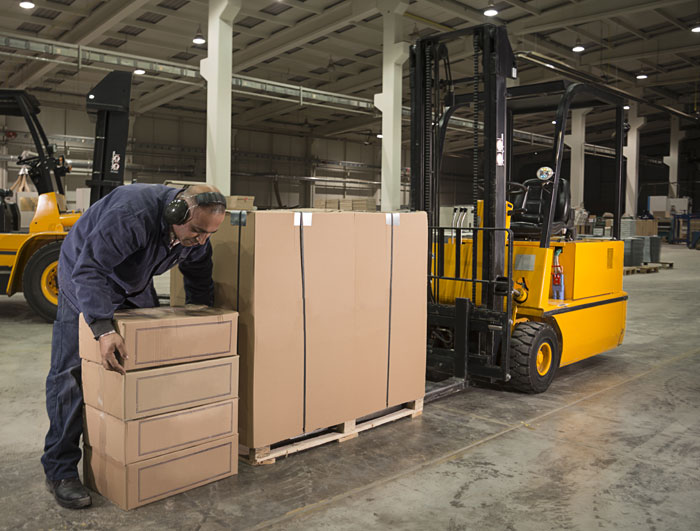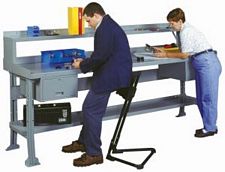Improving Ergonomics in the Warehouse
Tips on how you can reduce the strains on your employees in the facility

With the rising costs of workers’ compensation insurance and global pressures to increase productivity, warehouse and distribution center managers are taking a much closer look at improving ergonomics. With as many as 65% of worker’s compensation claims associated with manual materials handling, insurance companies are raising their rates—or mandating ergonomic improvements for continued coverage.
Equipment suppliers are responding to the need, engineering and designing features into their products to help workers minimize the strains associated with lifting, reaching, twisting, pulling and pushing. These new product features can also help address the demand for increased productivity as well.
Ergonomics matter for every facility
Lift tables optimize access to loads, items

One way to minimize worker fatigue and ease back strain while lifting is to keep the material being handled at a height between 30 inches (the average distance of a person’s knuckles to the floor) and 40 inches (the average distance of a person’s hands to the floor when the elbows are bent). When it comes to lift tables, they’re often used to load pallets because they position the pallet off the floor and keep the cartons being loaded or unloaded within the ideal 30 to 40 inches.
A variety of tables can do things like rotate a load, automatically adjust its height, tilt a bin of parts and present product at the correct position for workers, and make pallet loading and unloading much less stressful and difficult.
Forklift features for comfort, ease of operation
The ergonomic features and enhancements offered in stand-up and sit-down lift trucks start at the point of entry. Once in the vehicle, there’s been an increased emphasis on using mast designs that enhance visibility of the load and its destination, particularly at heights up to 500 inches. High visibility also extends to the latest displays, due to screens are becoming easier to read, with larger numbers and messages that explain an issue—rather than a code that has to be looked up in a manual. Specifically within stand-up models, where an operator can often spend a full day upright, features for postural relief include hip padding, leaning perches, and large active floorboard areas that allow operators to move/shift their feet. Vibration reduction is also critical on sit-down vehicles, which can be outfitted with special suspension seats and arm rests that adjust in a variety of ways.
Technology at workstations minimize repetitive motion strains
 Workstations, particularly those used for packing products prior to shipment to individuals, can provide a large range of ergonomic enhancements.
Workstations, particularly those used for packing products prior to shipment to individuals, can provide a large range of ergonomic enhancements.
Customization is king. To that end, a number of workstation solutions integrate the supplies and equipment right at a workstation—such as, protective packaging, printers, scanners, scales and computer components—to maximize work space and provide the packer with easy access to these items. With the rise of omnichannel retailing, more retail stores are adding one or more packaging workstations to their back room areas. Looking forward, expect to see more manufacturers and distributors implement collaborative robotics solutions to further improve worker ergonomics, letting the robots do the heavy lifting and transport from conveyor to workstation for example.
Conveyor ergonomics are critical in distribution facilities
Since employees frequently interact with conveyors, one of the best ways to increase ergonomic performance is to focus on your conveyor system. Are the workstations designed for picking in the golden zone? Do employees have to bend or stretch to reach loads? Are they forced to strain to move loads on or off the conveyor? These are all issues you can solve by designing your conveyors with ergonomics as a top priority. Built right, a conveyor system will reduce musculoskeletal disorders; wrong and it could exacerbate the issue.
When your conveyor delivers a load to a worker for packing, picking, shipping or assembly, that load should be in position. Don’t force the worker to rotate, shove or lift it. There are plenty of methods to lower, raise, position and rotate conveyor loads.
See Ergonomics and conveyor workstation design for more information.
Poorly designed ergonomics is less productive, more expensive
These are just a few examples of how improving the ergonomics of certain areas in your facility can lead to fewer injuries and more efficient employees. In the typical warehouse or factory, there are usually multiple opportunities to increase ergonomics and reduce the chances of injury and worker compensation.
Tags: Material Handling, order fulfillment, warehouse safety, ergonomics, plant safety, Order Picking & Fulfillment, Safety & Ergonomics
Evan Fleishacker




